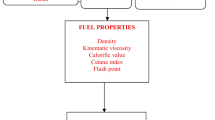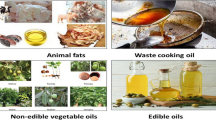Abstract
The cetane number is the most significant property for measuring the ignition quality of fuels for compression ignition diesel engines. In this study, the derived cetane number (DCN) of several types of biodiesel, biodiesel components and ultra-low sulfur diesel (ULSD) was determined using an Ignition Quality Tester (IQT™). The chemical structure of FAME leads to a higher cetane number of biodiesel compared to ULSD. The contribution to DCN from minor components present in biodiesel is not significant. Oxidation of biodiesel samples results in higher DCN values while depending on the conditions of oxidation. A greater than 25% increase was observed when oxidation was carried out in a way to retain volatile oxidative products such as carboxylic acids and aldehydes. Accelerated oxidation of cotton seed oil (CSO) biodiesel at 110 °C and 10 L/min air flow rate after 210 min resulted in a loss of 14% of the FAME content, of which 10% can be attributed to the oxidation of methyl linoleate (C18:2), whereas oxidation of soy bean oil (SBO) biodiesel resulted in a loss of 21% total FAME after 210 min. A significant amount of methyl linolenate (C18:3) remained un-reacted after 210 min of oxidation. Ambient oxidation of distilled biodiesel samples resulted in a very high cetane number. Oxidative products such as aldehydes, hydroperoxides and oligomers of FAME are probably responsible for this higher DCN. This study enhances the understanding of the effect of composition on the cetane number of biodiesel as well as the effect of oxidative aging on both biodiesel composition and the resultant DCN.








Similar content being viewed by others
References
Heywood JB (1988) Internal combustion engine fundamentals. McGraw-Hill, New York
Haas MJ, Scott KM, Alleman TL, McCormcik RL (2001) Engine performance of biodiesel fuel prepared from soybean soapstock: a high quality renewable fuel produced from a waste feedstock. Energy Fuels 15:1207–1212
McCormick RL, Graboski MS, Alleman TL, Herring AM (2001) Impact of biodiesel source material and chemical structure on emissions of criteria pollutants from a heavy-duty engine. Environ Sci Technol 35:1742–1747
Ladommatos N, Parsi M (1996) The effect of fuel cetane improver on diesel pollutant emissions. Fuel 75:8–14
Tao Y, Operation of a cummins N14 diesel on biodiesel: performance, emission and durability. National Biodiesel Board, Ortech Report No. 95-E11-B004524
Operators Manual, PowertechTM 2.4 L & 3.0 L 4024 and 5030 OEM Diesel Engines, OMRG34851, Issue 13 Oct 04, John Deere Power System, Moline
Ramadas AS, Jayaraj S, Muraleedharan C, Padmakumari K (2006) Artificial neural networks used for the prediction of the cetane number of biodiesel. Renew Energy 31:2524–2533
Knothe G, Matheaus A, Ryan III T (2003) Cetane numbers of branched and straight-chain fatty esters determined in an ignition quality tester. Fuel 82:971–975
Knothe G, Bagby M, Ryan III T (1998) Precombustion of fatty acids and esters of biodiesel. A Possible Explanation for differing cetane numbers. J Am Oil Chem Soc 75(8):1007–1013
Szybist J, Boehman A (2005) Evaluation of formation strategies to eliminate the biodiesel NOx effect. Fuel Process Technol 86:1109–1126
Conceicao MM, Fernandes VJ, Araujo AS, Farias MF, Santos IMG, Souza AG (2007) Thermal and oxidative degradation of castor oil biodiesel. Energy Fuels 21:1522–1527
Quantification and improvement of the long term storage stability of biodiesel and biodiesel blends (1997) NBB Project No. 96207–1, Final Report, December 1
Matthaus, Bertrand W (1996) Determination of the oxidative stability of vegetable oils by rancimat and conductivity and chemiluminescence measurements. J Am Oil Chem Soc 73(8):1039–1042
Van Gerpan JH, Hammond Y, Monyem A (1997) Determining the influence of contaminants on biodiesel properties. SAE Technical Paper Series, 971685
Monyem A, Van Gerpen JH (2001) The effect of biodiesel oxidation on engine performance and emissions. Biomass Bioenergy 20:317–325
Monyem A, Van Gerpen JH, Canakci M (2001) The effect of timing and oxidation on emissions from biodiesel-fueled engines. Trans ASAE 44:35–42
Knothe G (2006) Analysis of oxidized biodiesel by H-NMR and effect of contact area with air. Eur J Lipid Sci Technol 108:493–500
Meyer- Pittroff OFR (2004) The effect of fatty acid composition on biodiesel oxidative stability. Eur J Lipid Sci Technol 106:837–843
Knothe G, Steidley KR (2005) Lubricity of components of biodiesel and petrodiesel. The origin of biodiesel lubricity. Energy Fuels 19:1192–1200
Frankel EN (2005) Lipid oxidation, 2nd edn edn. The Oily Press Ltd, Bridgewater
Miyashita K, Takagi T (1986) Study of the oxidative rate and prooxidant activity of free fatty acids. J Am Oil Chem Soc 63(10):1380–1384
Dunn RO (2005) Effect of antioxidants on the oxidative stability of methyl soyate (biodiesel). Fuel Process Technol 86:1071–1085
Dunn RO (2002) Effect of oxidation under accelerated conditions on fuel properties of methyl soyate. J Am Oil Chem Soc 79:915–920
Neff WE, El-Agaimy MA, Mounts TL (1994) Oxidative stability of blends and interesterified blends of soybean oil and palm olein. J Am Oil Chem Soc 71(10):1111–1116
Murphy MJ, Taylor JD, McCormick RL (2004) Compendium of experimental cetane number data, NREL Report, NREL/SR-540-36805
Acknowledgments
Financial support from the Department of Energy (Grant DE-FG36-05GO85005) and the Michigan 21st Century Job Funds for this research are gratefully acknowledged.
Author information
Authors and Affiliations
Corresponding author
About this article
Cite this article
Wadumesthrige, K., Smith, J.C., Wilson, J.R. et al. Investigation of the Parameters Affecting the Cetane Number of Biodiesel. J Am Oil Chem Soc 85, 1073–1081 (2008). https://doi.org/10.1007/s11746-008-1290-2
Received:
Revised:
Accepted:
Published:
Issue Date:
DOI: https://doi.org/10.1007/s11746-008-1290-2




